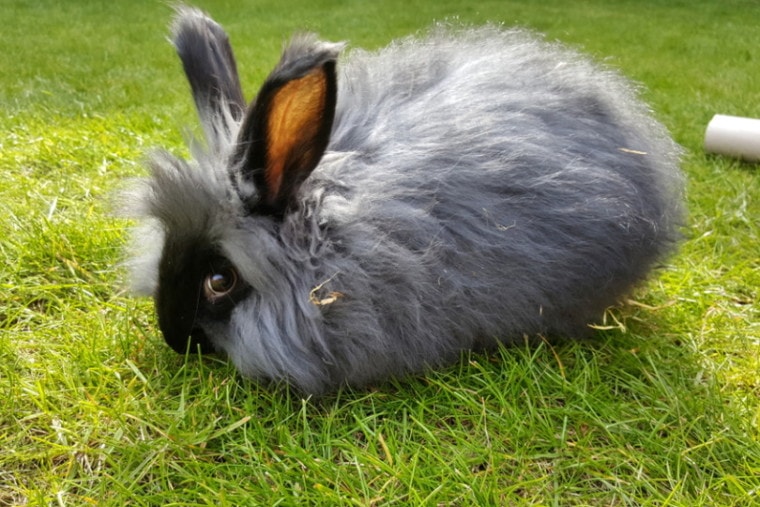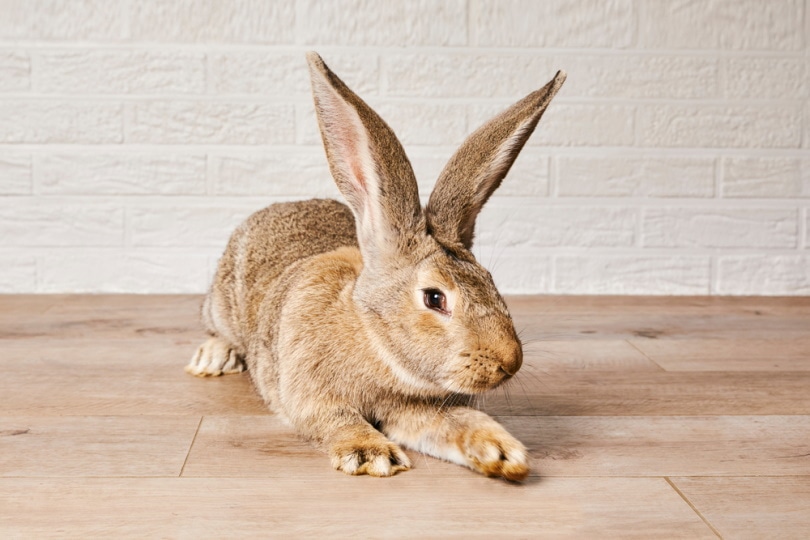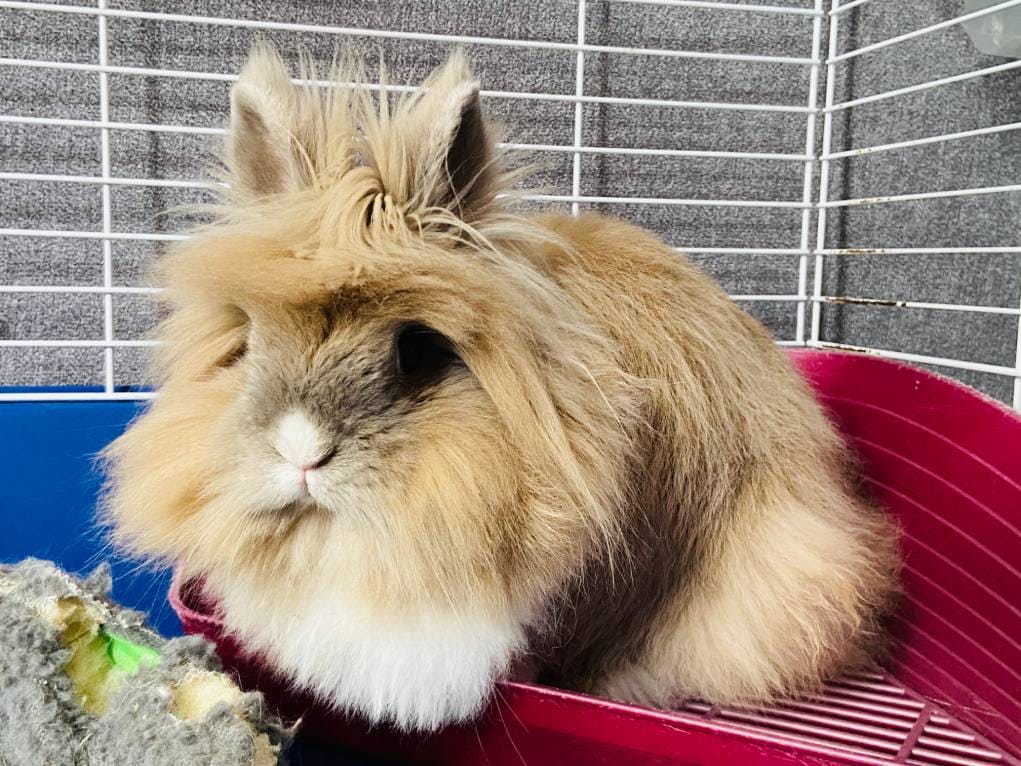
Click to Skip Ahead
The Angora rabbit is older than almost any breed and has a unique use in the companion animal world. Angora rabbits come in many shapes and sizes, but when referring to an “Angora,” most people mean the English Angora as the standard. The English Angora is the progenitor to all others, spawning three additional breeds recognized by the American Rabbit Breed Association (ARBA) and seven more unrecognized ones. In this article, we’ll discuss the beautiful Angora, what you’ll need to care for one, some interesting facts about them, and what they’re like to own.
Breed Overview
Size:
Medium
Weight:
Up to 7.5 lbs
Lifespan:
7–10 years
Similar Breeds:
American Fuzzy Lop, French Angora, Satin Angora
Suitable for:
Experienced rabbit owners prepared for grooming sessions, families with older children
Temperament:
Friendly, calm, good-natured, sociable
The Angora is a rabbit like no other. While most rabbits have smooth, sleek fur, the Angora boasts a wonderfully wooly coat that’s long and ever-growing. It is known for the light and hollow fibers of its coat, which made the rabbits incredibly popular with French royalty in the 18th century. So, the Angora was an instant hit when they made their way to the US in the early 20th century.
Now, garment makers spin angora fur into wool to produce a lighter, warmer version of cashmere. The Angora isn’t for the faint-hearted; while they’re mild-mannered and calm, they require daily intensive grooming to keep them comfortable and prevent dangerous matting and tangling of their fur.
Angora Rabbit Characteristics
How Much Do These Rabbits Cost?
The Angora is a beautiful rabbit, and its price is higher than what you might pay for a different breed. However, price variation depends on where you live and whether or not the rabbit has a “pedigree.” If you’re looking to purchase a baby Angora from a breeder in the US, prices fall between $50 and $200 depending on age, sex, and location. We saw Angoras for sale for $50 to $100 from one rabbitry. You might have difficulty finding an Angora from a rescue center (as they’re so popular), but older rabbits who are retired from showing are cheaper than babies.
Temperament & Intelligence of the Angora Rabbit
The Angora rabbit breed is a very old one, having been domesticated since at least the 18th century. Domestication has mellowed their temperaments and made them calm, even-tempered, and friendly to their human owners. Angoras love to play and interact with humans and other rabbits; they are clever enough to learn tricks, including coming when called and playing fetch! All rabbits are intelligent, and the Angora is no exception.
An Angora will learn its name, and most (if not all) can easily be taught to use a litter box, as rabbits are very clean animals. However, remember that an Angora’s long fur will need lots of attention to keep it clean after visits to the litter box!
Do These Rabbits Make Good Pets? 👪
Angora rabbits are great in terms of temperament and sociability. They’re not too small or large to handle comfortably (unless you have a dwarf or giant Angora), and they are good-natured and non-irritable if kept happy. However, they need extensive grooming to keep them healthy, a fact we can’t stress enough. If you think they’re cute but don’t think you have the time for daily and weekly grooming sessions, the Angora is not the rabbit breed for you.
If you can groom your Angora daily and learn how to strip its hair when it sheds, you’ll have a wonderfully relaxed companion that will happily play with toys and entertain you for hours. Like most rabbits, Angoras don’t like being picked up. However, they love to be petted and will snuggle up beside you once they’re comfortable to enjoy a relaxing grooming session. They make good pets for older children and adults as they are easy to manage once you understand their needs, but young children might be too much for them since they typically don’t like noise and sudden movements.

Does This Rabbit Get Along With Other Pets?
Angoras, like most rabbit breeds, can get along well with other pets in the home if they’re well socialized to them at a young age. All Angoras should have another rabbit to live with. They are incredibly social animals and can get stressed if they don’t have other rabbits to play with. As a prey species, rabbits can be fearful of larger pets (especially cats and dogs), but if all animals involved are well socialized, introduced slowly, and always supervised when together, many Angoras can form deep bonds with the animals living with them. As a precaution, take care when introducing your Angora to any dogs with a high prey drive (like Greyhounds, for example).
Things to Know When Owning an Angora
Angora rabbits are special as they have specific grooming and health needs. In addition, they have the same food and training requirements as all rabbits, and they need a playmate with space to play in to keep them happy.
Food & Diet Requirements 🥕
Angoras, like all rabbits, are obligate herbivores. This means that they can’t process animal protein and should be fed a diet of fiber-rich roughage and veggies. Rabbits need lots of roughage to keep them healthy and their gastrointestinal tract moving as it should, so Angoras should always have fresh hay available to them. An Angora’s diet should be 80% high-quality hay, such as Timothy or meadow hay. The amount should be unrestricted, meaning hay should be constantly replenished when it’s getting low. Don’t give your Angora straw or high protein, high-calcium hay like alfalfa or clover.
Dark, leafy greens should also be available daily for your Angora. The darker the leaves, the more nutrient-dense the veg generally is, so try to provide around a cup full of dark leafy greens per 2 pounds of your Angora’s weight daily. Greens such as spinach, radish greens, mustard greens, and parsley are good options. Try to serve various greens, but introduce them slowly to prevent diarrhea.

High-quality hay-based pellets should also be given to your Angora daily, but only around ¼ of a cup per 4 pounds of body weight. Too many pellets can cause obesity, which is detrimental to a rabbit’s health.
Lastly, fruits and “sweet” vegetables are excellent for providing your Angora with a healthy treat to motivate training! These foods should make up a small part of your Angora’s diet, but there are many options to choose from to keep things exciting. Bananas, berries, bell peppers, broccoli, carrots, melon, and pears are all great choices for treats, and they’ll keep your Angora happy and healthy when given in moderation.
Water should be freely available 24 hours a day, and both a gravity-fed bottle and a ceramic saucer are ideal, so your Angora has a choice.
Habitat & Hutch Requirements 🏠
Your Angora should ideally be kept inside the home. While rabbits have historically been kept outside, the threat of predators, adverse weather, and disease are much greater for outdoor rabbits. We recommend dedicating a space in your home to your Angora so they can enjoy your company without the dangers of living outside.
Every rabbit should have a “living” space they can call their own, such as a hutch or a cage. All rabbits should be able to stand up fully in their cage without touching the ceiling, hop three or four times in any direction without hitting the sides, lie down fully stretched out, and live in a quiet and calm environment. A cage for two rabbits (your Angora should never be kept alone) should be 4 feet tall and long and 2 feet wide for maximum comfort.
Solid-bottomed cages are better than wire mesh, and a comfortable, absorbent substrate should be available to rest on. Don’t use wood shavings in your Angora’s hutch, as they can easily damage their eyes and airways. A litter box, water bowl, food bowl, and hay should always be available in their living quarters. Litter waste and soiled bedding should be removed daily from your Angora’s home, especially since their hair is long and fine. It would be best to clean the entire cage bi-weekly with a rabbit-safe cleaner.

Exercise & Sleeping Needs 🐇
An exercise area for your Angora is essential; rabbits are highly active and intelligent animals. If they are kept indoors, you can dedicate a room to your Angora (free-roaming) or give them an extra-large puppy playpen to play in. If you’re using a whole room, rabbit-proofing the space is essential for your Angora’s safety. Removing anything that can be chewed, such as wires, and making sure the floor is non-slip and free of anything sharp is very important. Never leave your Angora to play unsupervised, as rabbits are easily frightened or hurt.
Providing your Angora with toys is important to their welfare, as they love to play! You can purchase your rabbit’s toys or make your own; your Angora can get hours of entertainment out of the simplest toys, such as toilet roll tubes, paper scrunched up into a ball, or a set of stacking cups. Just keep an eye out for anything being chewed, and remove any toys that appear damaged.
Your Angora will need a quiet, dark, and safe place to rest when they need to. Placing their cage or hutch in a room that can be shut off from the rest of the house is ideal, and keeping any other pets out of the room overnight will ensure they are safe and undisturbed when they sleep.

Training 🥎
Contrary to popular belief, rabbits are intelligent animals who can easily be trained! Your Angora will love to bond with you through training, particularly if a tasty treat is used as a motivator. Most rabbits will learn their names fairly quickly and teach themselves how to use a litter tray. With a little time, your Angora can learn how to come when called, play fetch, spin around, and even perform “show jumps!”
Training them to be more comfortable with handling is also a worthwhile endeavor as your Angora will have to spend lots of time sitting calm and still to be groomed. This includes getting them used to having their feet touched (most rabbits hate this) and being lifted up for health checks, but your Angora can be convinced to do almost anything when a little fruit is available!
Grooming✂️
Angora rabbits need the most grooming of any breed. Because their hair is so long, they can’t groom themselves. Unfortunately, this means that their owners must groom them daily. Otherwise, they can suffer terrible matting and tangling. If an Angora is ungroomed, their fine hair will begin to tangle almost immediately. This leads to matting and clumping of the coat, which pulls painfully on the skin and can cause open sores, infection, and fly strike.
During shedding season, an Angora will begin to lose copious amounts of hair that need to be stripped and collected. Most Angoras are clipped or hand stripped (pulling out the shed hair by hand) once every three months, as significant welfare issues can arise if the fur is left to tangle. In addition, Angora rabbits may not be able to eat or defecate if matted hair prevents it, so owners must be willing to groom them daily to keep them healthy and happy.
A bonus to this grooming is its bonding opportunities; plus, Angora rabbit fur makes an excellent felting wool!

Lifespan and Health Conditions🏥
The Angora rabbit has an average lifespan compared to other breeds and can live up to 10 years if kept happy and healthy. Indoor rabbits live longer than outdoor ones due to protection from the weather, disease, and potential predators. However, the Angora rabbit is more at risk of certain health conditions that could shorten its lifespan due to its long coat.
Male vs Female
There are very few differences between male and female Angora rabbits. Female rabbits tend to be more active and less relaxed, but this can vary significantly from rabbit to rabbit. Some female Angoras will develop a dewlap (a section of extra skin and fat around the chin for nesting), but some males can also grow a dewlap. Males may be slightly heavier, but the only real difference between male and female Angoras is their genitalia.
The 3 Little-Known Facts About Angora Rabbits
1. Angora Wool Sells for $10 to $16 Per Ounce and Is Some of the Most Valuable Wool in The World.
2. The Long, Wooly Hair of The Angora Is Genetic and Caused by a Gene Called “L,” Which Is Only Expressed in the Angora Rabbit Group.
3. Angora Rabbits (and Wool) Can Come in 15 Recognized Colors!

Final Thoughts
The Angora rabbit is a loving and calm breed with an exceptional appearance. They have hair cascading down their faces and billowing out of their bodies, so any potential Angora owner needs to be prepared to maintain intense grooming before purchasing one! Angoras need all the care a regular rabbit does, but special accommodations must be made for their grooming and health needs. If owners don’t groom their Angoras enough, their fur can become matted within days, and they can suffer significant pain. If you can commit to the grooming, however, you’ll have a playful and bright companion with the most beautiful fur!
Featured Image Credit: Evita Trankale, Shutterstock








